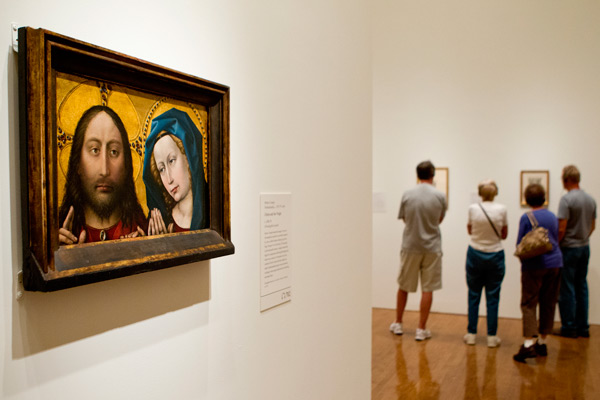
NEW YORK (CNS) — The relationship between art and the sacred is an unsolved problem of culture that exposes contradictions among society’s less-than-consistent moral, religious and political ideologies, according to speakers at an April 25 forum at Jesuit-run Fordham University. The program, “Taking Offense: When Art and the Sacred Collide,” examined controversies over disturbing artistic treatments of religious imagery.
Speakers said thoughtful consideration of the collision is often precluded by reflexive, cliched, self-righteous reactions to provocative art of negligible significance.
“Most of the public discussion over the conflict between art and the sacred is simplistic, partisan, shrill and sublimely dopey,” said Dana Gioia, former chairman of the National Endowment for the Arts and professor of poetry and public culture at the University of Southern California.
Camille Paglia, university professor of humanities and media studies at the University of the Arts in Philadelphia, criticized contemporary artists for mediocrity, “cynical snarky atheism,” cowardly provocation and ignorance of religion. A self-described atheist who was raised Catholic, Paglia said, “Respect for religion and interest in religion should be absolutely basic in any educated person. In order to understand the history of art, you need respect for religion.”
Gioia said there is a chasm between the church and the contemporary arts world. The church has moved away from its historic role as patron, promoter and conservator of the arts and “retreated mostly into sentimental kitsch.” The American arts have become isolated from one another, collectively remote, increasingly irrelevant and starved for something, he said.
As a result, the American arts world is spiritually impoverished by the loss of “a transcendent religious vision and a refined and rigorous sense of the sacred,” he said. Concurrently, “the loss of the aesthetic sensibility of the church and its disengagement with the broader artistic culture has weakened its ability to make its call heard in the world.”
“Once you remove the religious as one of the possible modes of art, once you separate art from the long-established traditional discipline of the spiritual, once you remove 2,000 years of religious symbol, ritual, language and mythos that has long animated Western art, you don’t remove the spiritual hunger of the artist or the audience, but you satisfy it more crudely with vague, pretentious and sentimental substitutes,” Gioia said.
Artists in America have no idea of their general audience and live in an echo chamber, where they hear only their own voices, Paglia said. As a result, they are widely disrespected by a majority of the population and considered hoaxsters and con men.
“The art world has been staking its own exclusivity and prestige on works of mediocrity,” she said. “The provocations that make people who live in Manhattan proud have resulted in the gutting of art programs nationwide. Schoolchildren are paying the price for Manhattan arrogance.”
She faulted artists for making uninteresting work and then hiding behind banal explanations when controversy erupts. “If you’re going to have blasphemous art, it should be done with imagination. And if you’re going to commit blasphemy, cop to it!”
Paglia dismissed Andres Serrano’s photo of a plastic crucifix immersed in the artist’s urine as “a work of schlock” and said it gained importance because it caused “a big political dustup” and not because it was high quality. She said the artist gave a mealy-mouthed explanation of the piece, rather than admitting his intent, and the art world was foolish to “go to the mat” in his defense.
Museums have “milked controversy to get better box office” and exhibited third-rate works of art below their standards, she said.
Both speakers said the church’s discomfort with nudity contributed to the tension between art and the sacred. Paglia said church art should not be innately lustful, but should acknowledge the Renaissance concept that physical beauty mirrors spiritual beauty. “To understand the history of art, you need to be able to be able to appreciate sex and eroticism,” she said.
The program was sponsored by the Fordham Center on Religion and Culture and marked the center’s final presentation under the leadership of founding co-directors Peter and Margaret O’Brien Steinfels, who are retiring.
The Steinfels established the center in 2004 to explore questions arising at the intersection of religious faith and contemporary culture. James P. McCartin, co-director since September 2011, will become the center’s director.
—By Beth Griffin, Catholic News Service






